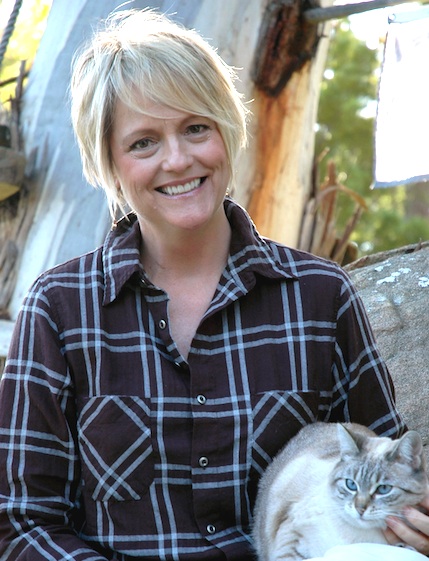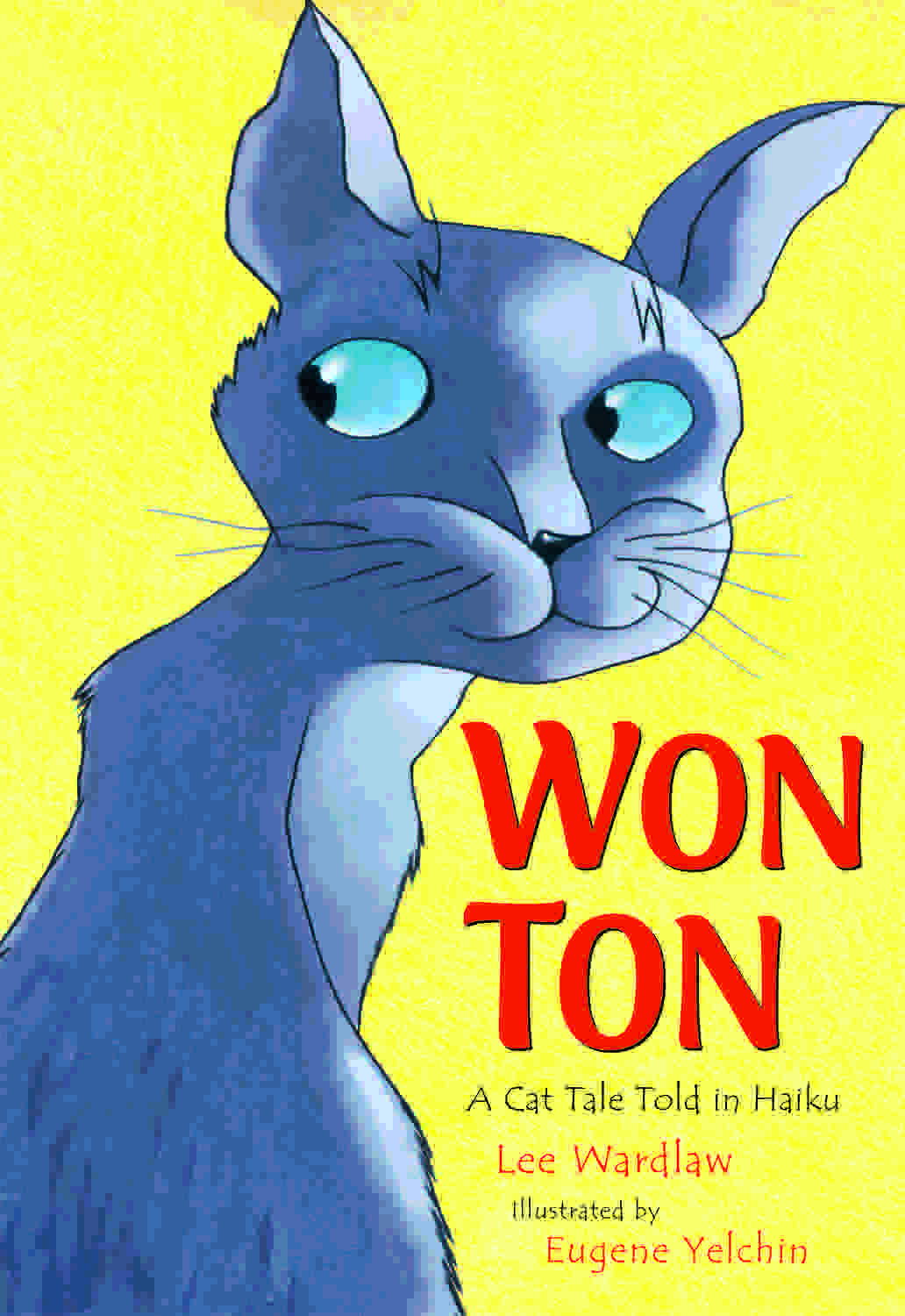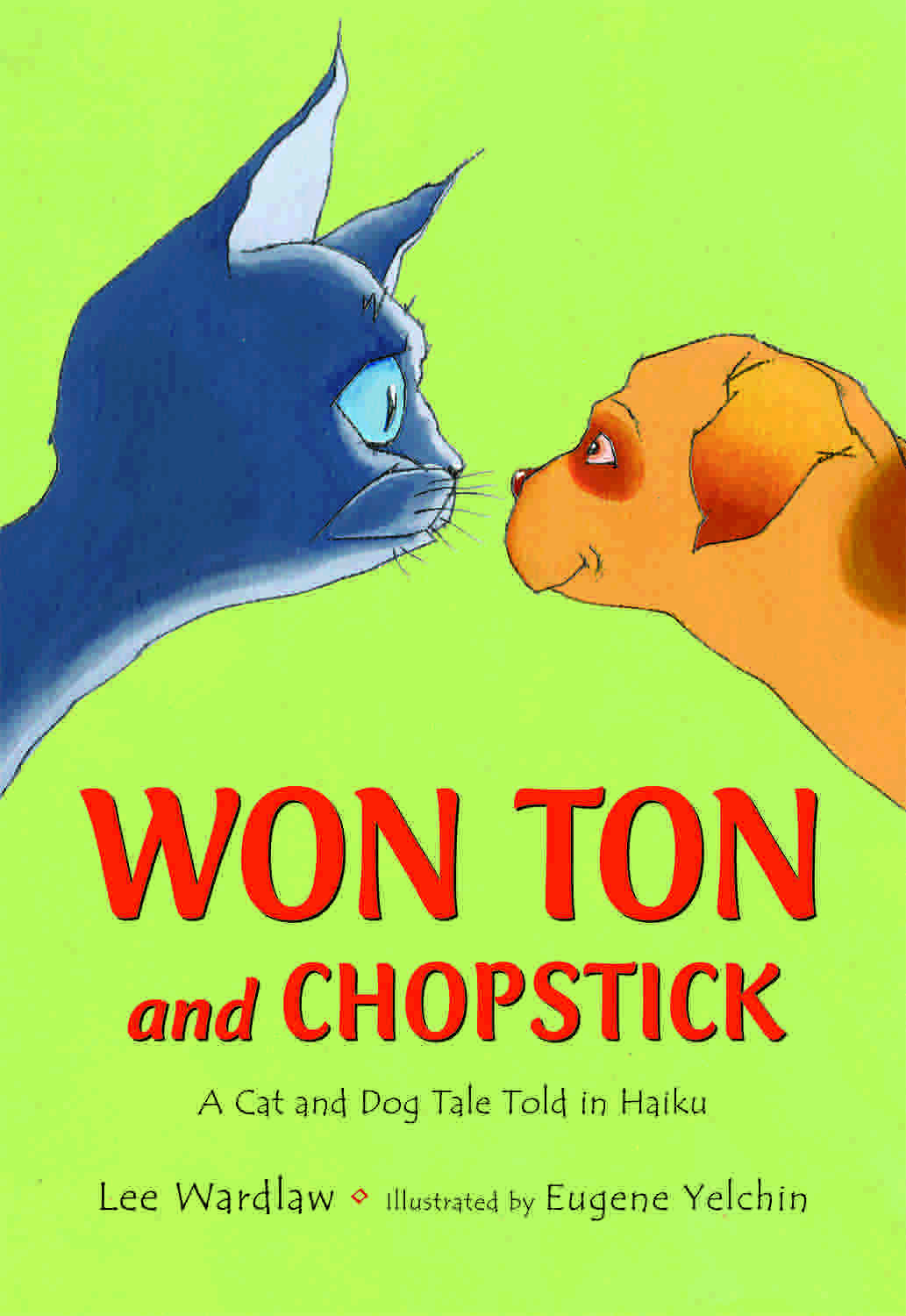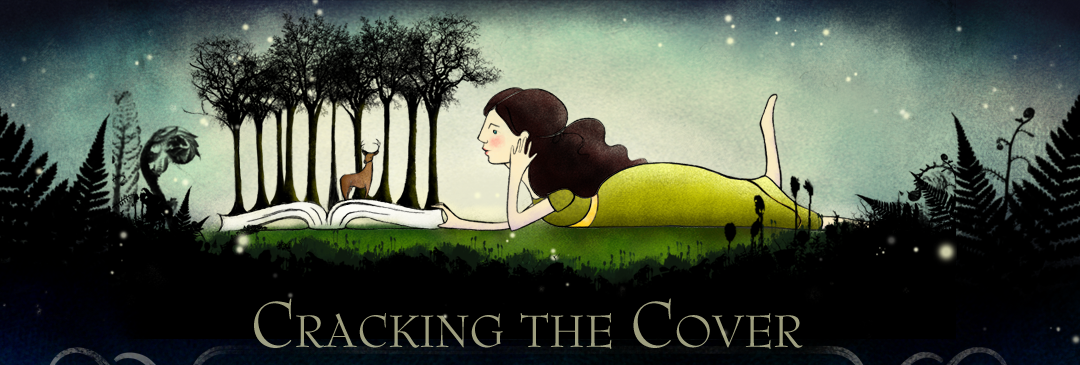
Lee Wardlaw is the author of 30 books for young readers, including “Won Ton: A Cat Tale Told in Haiku” and its follow-up, “Won Ton and Chopstick: A Cat and Dog Tale Told in Haiku.” The following is a complete transcript of her interview with Cracking the Cover.
Why do you write?
For many reasons:
- First and foremost, to entertain myself. (I mean, if I’m not having fun, why bother?)
- To work through difficult experiences, relationships, emotions, etc.
Examples:
After my family home and neighborhood were destroyed in a Santa Barbara wildfire, I wrote my first YA novel Corey’s Fire http://leewardlaw.com/corey.htm.
My feelings of alienation on the playground when my third-grade classmates made fun of my sack lunch (bologna-and-mustard-and-BBQ-potato-chip-sandwiches) inspired my easy-reader Dinosaur Pizza. http://leewardlaw.com/dino.htm
#2 leads into…
- To demonstrate to the reader that she can work through the difficult experiences, relationships, and emotions in her life—and that her life is worth the effort; that her life is worth living.
- To celebrate amazing experiences, relationships, emotions, etc.
Examples:
As a child, the 4th of July was my favorite holiday. I loved the boom-boom of parade drums reverberating in my chest . . . sticky-sweet watermelon juice trickling down my chin as I spat seeds at my little brothers . . . bundling in fishy sweatshirts on the deck of my family’s boat, all of us craning our necks to behold the burst and bloom of fireworks overhead. These memories are celebrated in my book for preschoolers Red, White and Boom! (Holt, illustrated by Huy Voun Lee). http://leewardlaw.com/red_white_boom.htm
101 Ways to Bug Your Friends and Enemies (Note: it’s a middle school novel, not an instruction manual!) celebrates my all-time favorite play Cyrano de Bergerac by Edmond Rostand. It also commemorates the agonies and the ecstasies of several of my first crushes. Sigh. http://leewardlaw.com/101ways_friends.htm
And, of course, Won Ton was inspired by the real-life adoption of our cat, Papaya, and the friendship that developed between him and my son. (From Day One they were buddies: reading together, sleeping together, playing together . . . even drinking out of the same cereal bowl together!)
 Why do you write for young people?
Why do you write for young people?
I wrote my first novel in second grade. It was about a girl named Teena Belle who has 14 baby brothers and 14 baby sisters—all in diapers. Her mother expects her to help with Diaper Duty. So, naturally, Teena Belle runs away from home. (Wouldn’t you?) I’m sure the novel was inspired by the birth of my youngest brother (of two, not fourteen!) and my impending diapering services. In sixth grade, I wrote (in long-hand) two 60-page novels, both about girls my age. (One was a mystery story with murders! The other was an adventure story . . . with murders!) My point is: I never intentionally sat down and thought: “I’m going to write for kids.” I wrote stories about kids because I WAS a kid. And, as the years went on, I kept writing about kids. I’m not sure why. The stories just came out—and continue to come out—that way. Maybe it’s because I don’t think I have anything to say to adults. Maybe it’s because I love the fresh way children look at the world. They’re like wide-eyed kittens, curious about, and ready to pounce on, anything that might be hiding around the next corner: Mystery! Adventure! Romance! Wheeee!
This is your second Won Ton book. Why did you decide to revisit the character?
Well, first because it was fun to write from his point of view. (See my answer to Question #1!) But also because I didn’t think his story was over.
Why Haiku?
Why not?
Seriously, though, when I first conceived the idea for Won Ton, I thought long and hard about how this cat would relate his story. Prose? Too ordinary. Rhyme? Too cutesy. And then it came to me: Haiku. Cats are haiku. They are both the epitome of Zen. They are present. They are in the Now. So it made sense that if a cat were to speak human, he would do it in haiku. And I knew that kids would relate to that sense of ‘Nowness’. They want cookies Now. They want to watch TV Now. ‘Tomorrow’ is such a long, long time away. . . .
 How did Chopstick’s character come about?
How did Chopstick’s character come about?
Well, I knew I couldn’t continue Won Ton’s story with his life being purrfect. I mean, cats spend a lot of time napping, bathing, eating, napping, purring, and . . . napping. That’s not a story—that’s boredom! I explain it to my readers this way: every story has a main character who is facing a conflict, an important problem he desperately needs to solve. So I thought: what’s the worst problem I could give Won Ton? The first idea I came up with was: the family adopts another cat! But that didn’t seem problematic enough. We have a multi-cat home, and although there was a bit of hissing and spitting in the beginning as each new feline was introduced into the family, the cats moved quickly from defending their territory, to resigned acceptance, to “let’s-sleep-in-a-pile-of-purr-on-the-bed.”
So then I thought: A dog! What better way to wreak havoc on Won Ton’s life than to force him to deal with another species! (Cue evil laugh.)
I didn’t tell Eugene Yelchin, the illustrator, what kind of dog to draw, though. The only suggestions I made were these: that Chopstick should be a puppy because it’s easier to introduce an older cat to a puppy than to a full-grown dog; that Chopstick should not be a hunting dog, pit bull, terrier, herding dog, or any type of hound because these are breeds that can be dangerous or annoying to cats. (I love how cute, round and cuddly Eugene drew Chopstick!)
One of the hardest things about creating Chopstick was choosing his name. I wanted a moniker that would be a good “companion” to Won Ton, as well as something a child could conceivably come up with. I did a lot of brainstorming; I also went outside and pretended to call the puppy, using various, potential names. “Chopstick” definitely won over “Fang!”
What makes Won Ton and Chopstick stand out among its contemporaries?
Won Ton’s voice is unique. And there aren’t many picture books written in linked haiku! Too, this book is a fresh way of telling the old “new-sibling-in-the-house-so-my-life-is-forever-ruined” story. It’s not only sibling rivalry—it’s species rivalry!
Why do you think your books appeal to young readers?
You can’t go wrong with animal stories—especially funny ones! Too, I think kids see themselves in Won Ton. They suffer many of the same emotions and problems and indignities that he does. (Except for the fleas. I hope.) He’s jealous of the toys and attention his “sibling” receives . . . he’s given time-outs for inappropriate behavior . . . he feels equally gleeful and guilty when Chopstick gets into trouble . . . etc
What are you working on now?
Can’t tell you. But I’m having fun batting around a few catnip mousies of ideas. . . .
Is there a book from your childhood that still resonates with you today?
There are heaps. But the first book I remember my mother reading aloud to me—and the one that probably instilled my fanatical love of cats—was Pussywillow by Margaret Wise Brown, illustrated by Leonard Weisgard. I was probably all of two or three years old, but even then I loved the gentle humor in the conversations between Pussywillow, the cat, and the animals and insects he meets on his journey. And Weisgard’s illustrations were just glorious in their depth of color and detail. I remember wanting to fall headfirst into those pictures so that I could live in that world.
